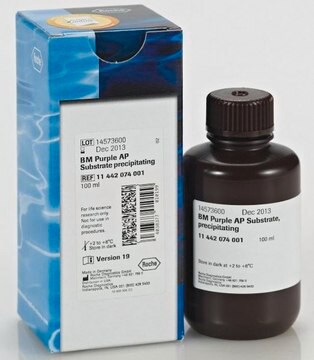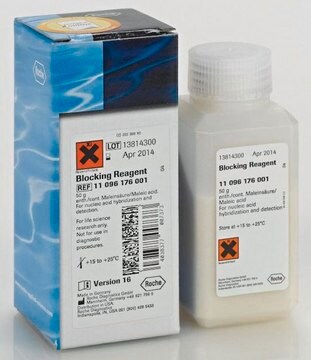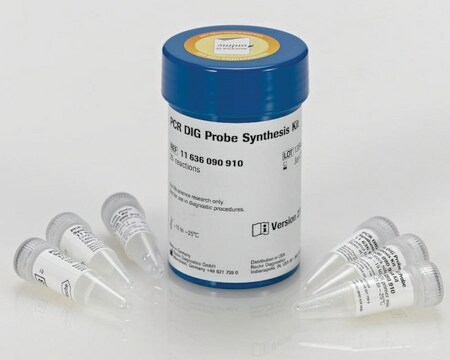おすすめの製品
フォーム
solution
品質水準
使用法
sufficient for 20 reactions
包装
pkg of 40 μL
メーカー/製品名
Roche
不純物
Ribonuclease, none detected (up to 20 µl using MSII-RNA)
色
colorless
溶解性
water: miscible
保管温度
−20°C
詳細
ラベリング効率:約10 μgのジゴキシゲニン標識化完全長RNAが、1 μgの直鎖テンプレートDNAから転写されます。
アッセイ時間:135分
サンプル材料
直鎖プラスミドDNA:
転写されるDNAが、SP6、T7またはT3 RNAポリメラーゼのためのプロモーターをポリリンカー付近に含む、適切な転写ベクターのポリリンカーサイトに複製されます。「ランオフ」転写物の合成のため、プラスミドは制限酵素によって直鎖化されます。5′-オーバーハングを生成する制限酵素を使用してください。3′-オーバーハングは避けてください。直鎖化されたテンプレートDNAは、RNアーゼのコンタミネーションを避けるため、フェノール/クロロホルム抽出およびエタノール沈殿によって精製してください。ランアラウンド用;転写環状プラスミドDNAが使用されます。
PCR生成物:
RNAポリメラーゼプロモーター配列を含むPCR断片は、転写用テンプレートとしても使用できます。転写に先立ち、HighPureカラム精製によってPCR断片を精製することをお勧めします。
アッセイ時間:135分
サンプル材料
直鎖プラスミドDNA:
転写されるDNAが、SP6、T7またはT3 RNAポリメラーゼのためのプロモーターをポリリンカー付近に含む、適切な転写ベクターのポリリンカーサイトに複製されます。「ランオフ」転写物の合成のため、プラスミドは制限酵素によって直鎖化されます。5′-オーバーハングを生成する制限酵素を使用してください。3′-オーバーハングは避けてください。直鎖化されたテンプレートDNAは、RNアーゼのコンタミネーションを避けるため、フェノール/クロロホルム抽出およびエタノール沈殿によって精製してください。ランアラウンド用;転写環状プラスミドDNAが使用されます。
PCR生成物:
RNAポリメラーゼプロモーター配列を含むPCR断片は、転写用テンプレートとしても使用できます。転写に先立ち、HighPureカラム精製によってPCR断片を精製することをお勧めします。
in vitro転写によって、DIG標識された任意の長さの一重鎖RNAプローブが生成されます。DIG-11-UTPは、標準的な条件下、SP6、T7およびT3 RNAポリメラーゼによって、転写物のおよそ20~25 番目の各ヌクレオチドに取り込まれます。DIG RNAラベリングミックスは、最適化された転写バッファーと共に提供されるSP6、T7およびT3 RNAポリメラーゼとの使用に特別にデザインされています。
RNAのジゴキシゲニン-11-UTP標識のための便利なヌクレオチド混合物です。
内容
以下を含む10倍溶液:10 mM ATP、CTP、GTP(それぞれ)、6.5 mM UTP、3.5 mM DIG-11-UTP。
RNAのジゴキシゲニン-11-UTP標識のための便利なヌクレオチド混合物です。
内容
以下を含む10倍溶液:10 mM ATP、CTP、GTP(それぞれ)、6.5 mM UTP、3.5 mM DIG-11-UTP。
特異性
熱失活:2 μLの 0.2 M EDTA(pH 8.0)を添加して反応を停止します。
アプリケーション
SP6、T7およびT3 RNAポリメラーゼでのin vitro転写による、RNAのジゴキシゲニン-11-UTPラベリング。DIG標識化RNAは、以下のような様々なハイブリダイゼーションテクニックで使用されます:
- ノーザンブロット
- サザンブロット
- ドットブロット
- プラークまたはコロニーリフト
- RNアーゼプロテクション実験
- クロモソーム、細胞、および組織切片in situ
特徴および利点
DIG RNAラベリングミックスは、最適化された転写バッファーと共にRocheから提供されるSP6、T7およびT3 RNAポリメラーゼとの使用に特別にデザインされています。
品質
DIG RNAラベリングキットおよびDIG核酸検出キットにおいて機能テスト済みです。
その他情報
ライフサイエンス研究のみに使用できます。診断には使用できません。
シグナルワード
Warning
危険有害性情報
危険有害性の分類
Acute Tox. 4 Oral
保管分類コード
12 - Non Combustible Liquids
WGK
WGK 1
引火点(°F)
does not flash
引火点(℃)
does not flash
この製品を見ている人はこちらもチェック
Marco Nousch et al.
Journal of cell science, 126(Pt 18), 4274-4285 (2013-07-12)
Post-transcriptional regulatory mechanisms are widely used to control gene expression programs of tissue development and physiology. Controlled 3' poly(A) tail-length changes of mRNAs provide a mechanistic basis of such regulation, affecting mRNA stability and translational competence. Deadenylases are a conserved
Nathalie Bessodes et al.
PLoS genetics, 8(12), e1003121-e1003121 (2012-12-29)
During echinoderm development, expression of nodal on the right side plays a crucial role in positioning of the rudiment on the left side, but the mechanisms that restrict nodal expression to the right side are not known. Here we show
Ryan B MacDonald et al.
Developmental dynamics : an official publication of the American Association of Anatomists, 239(8), 2298-2306 (2010-07-27)
The Dlx genes encode a family of transcription factors important for the development of the vertebrate forebrain. These genes have very similar expression domains during the development of the telencephalon in mice and play a role in gamma-aminobutyric acid (GABAergic)
Jiabin Chen et al.
Cerebral cortex (New York, N.Y. : 1991), 20(3), 650-660 (2009-07-03)
Experience-dependent plasticity of the adult visual cortex underlies perceptual learning and recovery of function following central nervous system lesions. To reveal the signal transduction cascades involved in adult cortical plasticity, we utilized a model of remapping of cortical topography following
Erica M Sommermann et al.
Developmental biology, 347(1), 154-166 (2010-09-03)
The transition from specification of cell identity to the differentiation of cells into an appropriate and enduring state is critical to the development of embryos. Transcriptional profiling in Caenorhabditis elegans has revealed a large number of genes that are expressed
資料
Digoxigenin (DIG) labeling methods and kits for DNA and RNA DIG probes, random primed DNA labeling, nick translation labeling, 5’ and 3’ oligonucleotide end-labeling.
Digoxigenin (DIG) labeling methods and kits for DNA and RNA DIG probes, random primed DNA labeling, nick translation labeling, 5’ and 3’ oligonucleotide end-labeling.
プロトコル
DIG RNA Labeling Mix Protocol & Troubleshooting
ライフサイエンス、有機合成、材料科学、クロマトグラフィー、分析など、あらゆる分野の研究に経験のあるメンバーがおります。.
製品に関するお問い合わせはこちら(テクニカルサービス)






